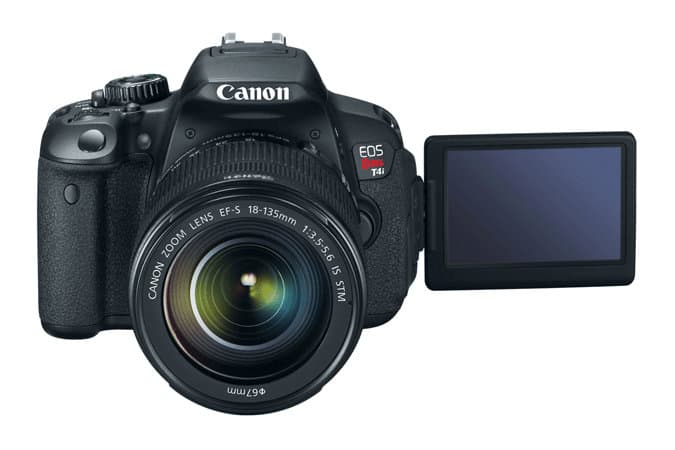Canon has announced it’s latest entry Rebel, the EOS T4i, and by all accounts it looks like a winner. In addition to a long list of predictably impressive specs — 18MP sensor with Digic 5 processor, ISO up to 25600, 9-point all cross-type auto-focus array, 5 fps burst shooting — the $849 (body only) Rebel marks a few firsts. For the first time ever on any DSLR, the T4i features a 3-inch pop-out capacitive touchscreen. This, I suspect, is a move to attract consumers who may be stepping up from a point-and-shoot; using a touchscreen should be far more intuitive then hunting down a physical button located somewhere around the top, rear, or even front of the camera. It won’t be long before touchscreen is the norm on DSLRs.
But the really big news, and the feature everyone will be testing to the nines, is continuous auto-focus for video.
Competitors such as Nikon (D5100, D7000) already introduced several models with this feature, so Canon is a step or two behind, but the T4i potentially levels the playing field. To use it you’ll need a new stepping motor (STM) lens. In tandem with the T4i, Canon has announced two of them: an EF-S 18-135 mm f/3.5-5.6 IS ($549) and EF 40 mm f/2.8 pancake lens ($199). Each will silently track subjects and automatically adjust focus while shooting video in live mode.
If it works as advertised, this will be a boon for those interested in using their DSLR like a camcorder. Recording a live concert, for example, would often require you to track a performer moving across the stage. Now you’ll not have to worry about resetting focus during the shot — as you would on the EOS 60D or early Rebels such as the T3i or T2i. To be clear, Canon has always had auto-focus for video – even while shooting you can depress the shutter (or push the AF-ON button) to get focus lock. The key here is continuous. Now the stepping motor will work in sync with the camera’s auto-focus algorithm to make small dynamic adjustments, all without making noise (important since you don’t want the motor noise ruining your audio track).
With the T4i, however, Canon risks cannibalizing its mid-range EOS 60D (my current weapon of choice).
The step-up model used to have a clear advantage over its entry-level siblings. Now, it’s not so evident. With the EOS 60D ($999 body only) you get slightly better build quality, longer battery life, and faster burst mode (but only by .3 fps!). Both models feature the articulating, pop-up display which is handy for shooting video. The T4i, meanwhile, offers improved ISO performance (up to 25600 vs. only 12800 for the 60D), and a built-in stereo mic (mono on 60D).
For many, the T4i is clearly the better choice. And it’s $100 less expensive to boot!
I primarily shoot video with my EOS 60D (and use a T2i for backup and occasionally as a second camera angle) so the T4i and the new STM lenses definitely entice. Word is Canon will announce the 70D — which will almost certainly include video auto-focus as well — in the fall (September-ish from what I’ve read on the forums). For me, that’ll be worth the wait. For others who are just getting into DSLR and previously contemplated a camcorder, I’d highly recommend the T4i. You’ll get all the benefits of a camcorder, such as auto-focus and a built-in mic, but you get a phenomenal DSLR camera, and depth-of-field (and resulting bokeh) that can’t be matched by point-and-shoots.
Quick tip: if you plan to primarily shoot video with a DSLR — T4i or otherwise — be sure to grab a Rode Videomic Pro. It only costs $229 and increases audio quality by an order of magnitude. The tiny shotgun mic sits in the shoe on top of the camera, and a small wire runs into the mic input. It’s discrete, and doesn’t impact the ability to take photos, or easily carry the camera around. I have one on my 60D about 95% of the time, and love it. If you want to learn more, you can read my Videomic Pro review here, or check it out on Amazon.
Here’s what video looks like from the 60D (which will be almost identical to the T4i) using a Rode Videomic Pro. Note that I wish I had continuous auto-focus as it would’ve helped track the dance-happy Janelle Monáe more sharply!

